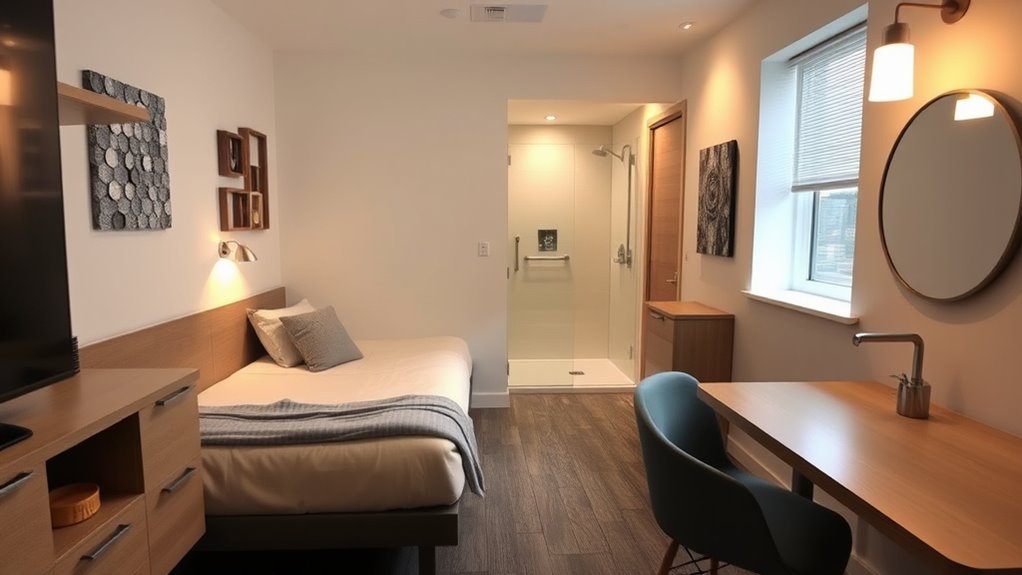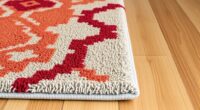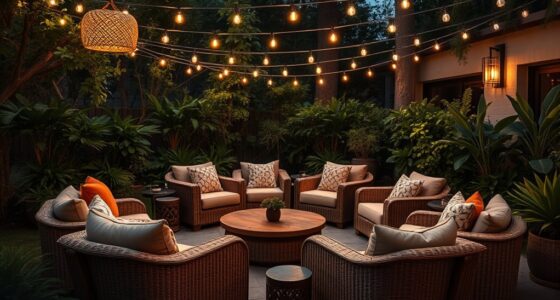To guarantee safety in your small studio for aging in place, prioritize wide, clear pathways of at least 3 feet, with minimal obstacles. Choose multi-functional furniture with rounded edges and keep essentials within easy reach. Use layered lighting and strategically placed mirrors to improve visibility, while incorporating grab bars and walk-in showers in the bathroom. Thoughtfully zone areas for living, sleeping, and eating to maximize space and safety—discover more tips to create a space that’s both functional and secure.
Key Takeaways
- Design open, unobstructed pathways at least 3 feet wide for easy mobility and hazard reduction.
- Incorporate multi-functional furniture with rounded edges and accessible storage to maximize space and safety.
- Use layered lighting, motion-activated fixtures, and strategic mirrors to enhance visibility and safety.
- Install grab bars, walk-in showers, and non-slip surfaces in the bathroom to prevent falls.
- Create distinct zones with furniture placement and rugs to organize space while maintaining accessibility.

Designing a studio layout that supports aging in place allows you to maintain independence while ensuring safety and comfort. When space is limited, every inch counts, so planning thoughtfully becomes essential. The goal is to create an environment where you can move freely without feeling cramped, yet everything you need is within easy reach. To do this, start by visualizing a layout that promotes smooth flow and minimizes obstacles. Clear pathways of at least three feet wide to accommodate mobility aids like walkers or wheelchairs. This way, you reduce the risk of tripping or bumping into furniture, which is *essential* for your safety.
Ensure clear, wide pathways for safety and easy movement in your aging-in-place studio layout.
Choose multi-functional furniture that maximizes space without sacrificing comfort. For example, a fold-down bed or a sofa bed allows you to save space during the day. Opt for pieces with hidden storage to keep clutter out of sight, maintaining a tidy, accessible environment. When selecting furniture, prioritize pieces with rounded edges—these are safer in case of accidental bumps, especially if mobility becomes more limited. Keep frequently used items close to where you spend most of your time; for instance, place your bed, seating, and essential supplies nearby to reduce unnecessary movement.
Lighting plays a *key* role in a safe studio layout. Incorporate layered lighting—overhead, task, and accent lighting—to eliminate dark corners and improve visibility. Motion-activated lights near entrances, bathrooms, and hallways can help you navigate safely at night without fumbling for switches. Mirrors strategically placed can also enhance space perception and light, making the room feel more open and brighter.
The bathroom requires special attention. It should be easily accessible with grab bars installed near the toilet and in the shower or tub. Consider a walk-in shower with no threshold to prevent tripping. Non-slip mats and surfaces are a must. Keep toiletries within arm’s reach to avoid stretching or bending down unnecessarily. In your kitchenette, use open shelving and compact appliances to conserve space. Make sure countertops are clear of clutter, and install lever-style faucets that are easier to operate.
Finally, think about creating distinct zones within your small space—living, sleeping, eating, and bathing—so each area serves its purpose without crowding. Use rugs or furniture placement to delineate these zones subtly. Remember, the key to a safe, functional studio lies in thoughtful design that prioritizes accessibility, minimizes hazards, and maximizes every inch for your comfort and independence.
Frequently Asked Questions
How Can I Maximize Storage in a Small Studio?
You can maximize storage in your small studio by using multi-functional furniture like beds with built-in drawers or fold-out desks. Vertical space is your friend—install shelves up high and hang hooks for bags or tools. Opt for storage ottomans and under-bed organizers to keep clutter out of sight. Keep surfaces clear and choose sleek, space-saving furniture to create an open, organized environment that feels larger and more functional.
What Are the Best Materials for Non-Slip Flooring?
You should choose materials like textured vinyl, rubber, or cork for non-slip flooring. These surfaces provide excellent traction, reducing the risk of falls, especially in areas prone to moisture like kitchens and bathrooms. Vinyl and rubber are durable, easy to clean, and affordable, making them ideal for small spaces. Cork offers a softer feel underfoot and natural slip resistance, combining safety with comfort for your daily activities.
How Can I Improve Lighting for Safety and Comfort?
Imagine casting a gentle glow that guides your steps with ease. To improve lighting for safety and comfort, add layered sources like ceiling lights, wall sconces, and table lamps to eliminate shadows. Opt for warm, bright bulbs that create inviting atmospheres and help you see clearly. Consider motion sensors for convenience and safety, especially at entryways. Bright, well-placed lighting transforms your space into a cozy, secure haven you’ll love to be in.
Are There Affordable Technology Solutions for Aging in Place?
Yes, there are affordable technology solutions for aging in place. You can install smart home devices like voice-activated assistants, automated lighting, and door sensors that respond to your needs without high costs. These tools enhance safety and independence by alerting you to hazards or controlling your environment easily. Many options are user-friendly and budget-friendly, making it simple to adapt your space without breaking the bank.
How Do I Ensure Privacy in a Compact Studio?
You can guarantee privacy in a compact studio by using strategic furniture placement to create distinct zones, like a bookshelf or curtain to separate the sleeping area from the living space. Incorporate room dividers or sliding doors for added separation when needed. Use curtains or screens around your bed for quick privacy. Keep noise to a minimum with soft furnishings, and choose multi-functional furniture that offers both storage and privacy options.
Conclusion
By thoughtfully designing your studio, you create a space that’s as safe as a fortress and as welcoming as a cozy home. With smart layouts and accessible features, you’ll feel confident and independent, even in a small space. Just like a well-tended garden flourishes in the right conditions, your living area can support your needs and comfort. Embrace these design tips, and turn your studio into a sanctuary where aging in place feels natural and secure.









